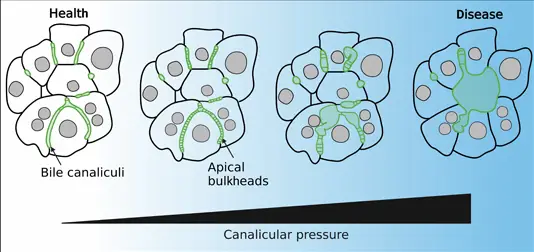Apical bulkheads accumulate as adaptive response to impaired bile flow in liver disease.

Graphical Abstract
Hepatocytic apical bulkheads protect bile canaliculi against dilation and hepatocyte rosette formation upon elevated canalicular pressure. These findings highlight the significance of canalicular pressure in liver diseases and the protective role of apical bulkheads in the adult liver.
Apical bulkheads accumulate in response to bile flow obstruction in mouse models and patients with primary sclerosing cholangitis (PSC).
Subsequent loss of apical bulkheads results in abnormally dilated canaliculi, resembling hepatocyte rosettes observed in other hepatic diseases.
3D reconstruction in PSC patients reveals that hepatocyte rosettes are sections of cysts and tubes formed by hepatocytes that occupy significant amounts of the network throughout the
Loss of apical bulkheads and rosette formation is primarily driven by increased elevated pressure and not bile acid signalling as demonstrated in experiments using primary hepatocytes and 3D organoids.
Abstract
Hepatocytes form bile canaliculi that dynamically respond to the signalling activity of bile acids and bile flow. Little is known about their responses to intraluminal pressure. During embryonic development, hepatocytes assemble apical bulkheads that increase the canalicular resistance to intraluminal pressure. Here, we investigate whether they also protect bile canaliculi against elevated pressure upon impaired bile flow in adult liver. Apical bulkheads accumulate upon bile flow obstruction in mouse models and patients with primary sclerosing cholangitis (PSC). Their loss under these conditions leads to abnormally dilated canaliculi, resembling liver cell rosettes described in other hepatic diseases. 3D reconstruction reveals that these structures are sections of cysts and tubes formed by hepatocytes. Mathematical modelling establishes that they positively correlate with canalicular pressure and occur in early PSC stages. Using primary hepatocytes and 3D organoids, we demonstrate that excessive canalicular pressure causes the loss of apical bulkheads and formation of rosettes. Our results suggest that apical bulkheads are a protective mechanism of hepatocytes against impaired bile flow, highlighting the role of canalicular pressure in liver diseases.
